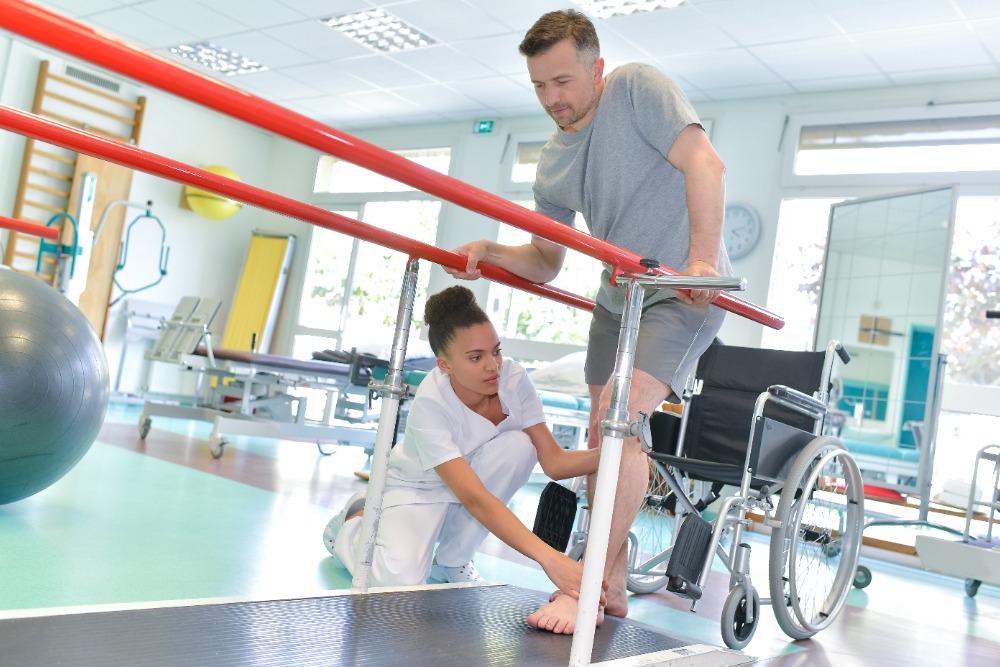The physical therapy industry continues to grow and expand due to its effectiveness as a supplement to other traditional practices. Like other healthcare workers, physical therapists have the opportunity to impact the lives of patients directly.
Physical therapists help to improve the quality of life for those in need through mobility-based practices that promote well-being.
Unlike some healthcare jobs, physical therapists get to see the direct results of their work through the formation of close doctor-patient relationships.
What Physical Therapists Do

Physical therapists work one-on-one with patients to offer quality care for mobility-related injuries or chronic conditions. Many patients require physical therapy for conditions that medicine alone cannot heal.
Through consultation with a healthcare team of physicians, surgeons, and other medical professionals, physical therapists evaluate patient injury and progress to determine their proper physical therapy recovery process.
By utilizing patient-individualized treatment plans, physical therapists can improve the quality of life for patients based on their specific needs. Physical therapy involves equipment, exercises, and hands-on training to assist recovery.
Physical therapists also have the opportunity to develop a connection with their patients through regular meetings and patient education. The physical therapy profession is excellent for anyone looking to make a rewarding impact on the lives of their patients.
How to Become a Physical Therapist

Before preparing for a career as a physical therapist, you should determine what level of education you are willing to pursue. To become a physical therapist, you must earn a Doctor of Physical Therapy (DPT) degree.
Becoming a Physical Therapist
Aspiring physical therapists can apply for a Doctor of Physical Therapy program after earning a four-year Bachelor’s degree. The Bachelor’s degree does not have to be related to physical therapy, but it may be helpful to have a healthcare background before continuing education. Some universities offer a 3+3 program that streamlines the process to 6 years, two years faster than the average schooling timeline.
DPT programs cover continuing education courses related to the physical therapy profession, including anatomy, biology, pharmacology, and kinesiology.
After earning a physical therapy degree, a student must pass the National Physical Therapy Examination and state licensure examination. Most physical therapists also complete clinical work before receiving certification. After passing the test, a student’s physical therapy education is complete, and they become a licensed physical therapist. From here, physical therapists can consider residency, board certification, or American Physical Therapy Association membership.
Becoming a Physical Therapist Assistant
Physical therapist assistants work alongside physical therapists. Physical therapist assistants are not doctors, so they cannot form patient diagnoses or create treatment plans. Instead, they assist physical therapists in carrying out treatment plans and working with each patient.
Physical therapist aides must graduate from an accredited physical therapy assistant program and pass a national PTA licensure exam. The timeline of this schooling is shorter than that of a physical therapist, typically taking two years to complete.
How Much Does Physical Therapy School Cost?
Reviewing the cost of physical therapy education programs before pursuing schooling is essential. Many DPT programs accept student loan repayment or offer scholarships to offset student debt.
The average annual cost of a public physical therapy program is $69,418. The average yearly cost of a private physical therapy program is $118,865.
These costs exclude other financial factors, including housing, meal plans, textbook cost, and transportation. Physical therapy students can expect to pay more than the above amount during their schooling.
Physical Therapy Pay

According to a 2021 report from the Bureau of Labor Statistics, the average annual salary of physical therapists is $95,620. The average yearly wage for physical therapist aides is $61,180.
According to the same report, the highest 10% of physical therapists earn more than $127,110, with the highest paying industries being home healthcare services, nursing care facilities, residential care facilities, and hospital settings.
Although schooling prices are high, these wages can help to offset student debt and student loan repayment.
Physical Therapy Working Conditions

The work environment for a physical therapist varies depending on work location, specialization, and hours.
Typically, physical therapists must be able to stay on their feet most of the day. They should also be physically able to demonstrate exercises, stretches, and other functional movements.
Physical therapists can work in various environments, including hospitals, outpatient care, nursing homes, private practices, and more.
Physical Therapy Job Trends

Current Number of Jobs
According to the Bureau of Labor Statistics, there are 238,800 physical therapy jobs in the U.S. Physical therapy job growth is predicted to be much faster than other occupations, with an average of 15,400 career openings per year.
Increased Demand for Physical Therapy
Physical therapists have been in high demand for several years, and the physical therapy job outlook will increase by 22% by 2028 (Bureau of Labor Statistics).
Part of the reason for this increased demand is the aging of previous generations. Aging baby boomers are beginning to require physical therapy for age-related health issues, expanding the job outlook for physical therapists.
Other healthcare factors impact physical therapy job growth, including the anticipated increase in health issues like diabetes and obesity, two chronic conditions also impacting aging baby boomers. Additionally, those in previous generations are at greater risk for heart attacks, strokes, and other mobility-related injuries, which will require physical therapy for proper recovery.
The success of physical therapy in mobility-related injuries and chronic conditions is significant. Compared to alternative treatments involving surgery and heavy medication, physical therapy offers a more holistic practice that promotes healing faster than the average surgery rates.
Increased Amount of Physical Therapists
While the average growth rate of physical therapy jobs is high, the number of people pursuing physical therapy schooling is also rapidly increasing.
Within the next decade, there may be a large influx of physical therapists. Due to a higher number of students enrolled in physical therapy school, physical therapists can expect employment rates to change as more people enter the profession.
Hospitals are the largest employers of physical therapists, meaning that physical therapists can find most jobs in hospital settings. Due to the average growth rate of students enrolled in Doctor of Physical Therapy programs, physical therapists may expect fewer hospital job openings or employment opportunities.
Alternatives for Professional Setting
Due to the nature of the career, many physical therapists suffer from burnout. While job satisfaction is typically high for physical therapists, it can become a demanding role.
Pursuing alternatives to traditional in-patient rehabilitation centers may be the way to avoid physical therapist burnout. Physical therapists can assess their work-life balance and gain experience by trying new work environments.
Outpatient and Private Practice
Working in an outpatient facility can be a great way for physical therapists to avoid burnout while still doing what they love. Private practices allow physical therapists to create their own hours that work with their desired work-life balance. Having your own practice as a physical therapist is something to consider if the typical hospital setting is causing you burnout.
Cash-based Practices
Cash-based practices are an excellent alternative for those who wish to avoid constant arguments with insurance companies. Third parties control various practice areas when working in hospital settings or rehabilitation centers, including financial purchases, medical technology, or healthcare procedures.
These restrictions can interfere with the treatment goals of a physical therapist. Cash-based practices allow physical therapists to control how they treat patients without adhering to third-party guidelines.
Traveling Physical Therapist Positions
Travel physical therapy jobs are an exciting option for physical therapists looking to switch up their work-life balance. Travel physical therapy jobs typically offer more money than the average physical therapy job. They also come with increased autonomy and the ability to travel within your career.
Physical Therapy Technological Advancements
Technology has helped increase physical treatments’ effectiveness and enhance physical therapy careers.
Wearable health monitors like the FitBit and Apple Watch feature sensors that help keep patients accountable for their at-home exercise. Enhanced tracking has helped physical therapists make more accurate diagnoses and recovery plans.
The emergence of telehealth has offered a variety of new career options outside of the traditional hospital setting. Telehealth capabilities allow for more constant and efficient communication between doctors and patients, revolutionizing the job outlook in the healthcare field.
Types of Physical Therapy Jobs
There is a vast amount of practice areas that physical therapists can choose to specialize in based on their own experience or preference, including:
- Geriatric
- Orthopedic
- Neurology
- Pediatric
- Women’s Health
- Oncology
- Electrophysiologic
- Sports
- Cardiovascular/Pulmonary
Similar Occupations
In addition to these specialties, physical therapists share the medical space with a few other similar occupations. These shared spaces allow for cross-occupational communication and collaboration, enhancing the patient experience.
Occupational Therapists
Occupational therapists share some overlap in job responsibilities but typically focus more on solutions beyond movement training to restore the quality of life for patients.
Athletic Trainers
Athletic trainers often work in educational or competitive sports settings to help treat sports-related injuries and promote athlete well-being.
Physical Therapy Assistants
Physical therapy assistants offer excellent support to physical therapists by helping to implement patient exercises.
How to Find Physical Therapy Jobs

Are you ready to kickstart your physical therapy career? Allied Travel Careers can help you find your dream physical therapy job through our simple application.
CLICK APPLY to Allied Travel Careers to get one step closer to a fulfilling physical therapy career!
